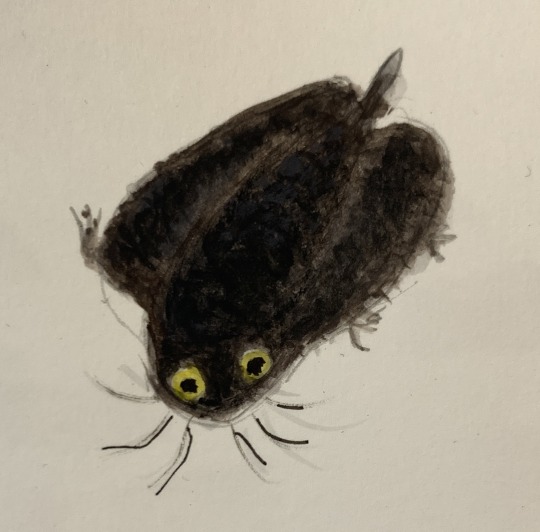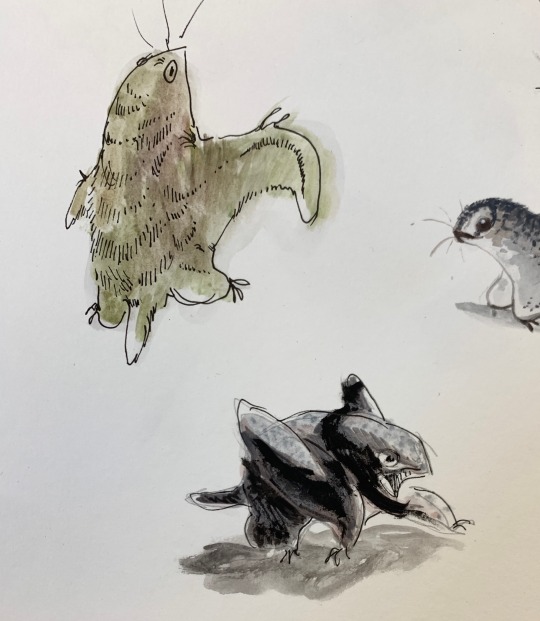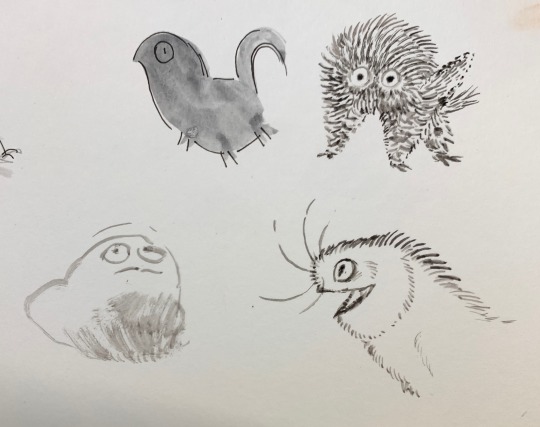Reblogs, Rambles, and Pixel badges. 18+ not required but recommended.
Last active 2 hours ago
Don't wanna be here? Send us removal request.
Text

Entangled lovers
2K notes
·
View notes
Text
married couple gyu…how delightful
549 notes
·
View notes
Text






Leopard Seal appreciation moment
260 notes
·
View notes
Text

number 4!
Pterodactylus ("winged finger")
This pterosaur was one of the first prehistoric reptiles to be discovered, they lived in Germany 150-148 million years ago, they had wings formed by a skin and muscle membrane with a wingspan of about 1 meter, a soft-tissue crest on their heads and they used to hunt small animals in coastal areas and shallow waters.
47 notes
·
View notes
Text




Creature from the black lagoon
12K notes
·
View notes
Text

dust you are
and to dust you will return
753 notes
·
View notes
Text
Europejara olcadesorum

By Vitor Silva, retrieved from http://www.pteros.com/, a website dedicated to education about Pterosaurs.
A reminder that we will not be able to do every pterosaur until we reach $240 in donations on our patreon, so please donate even a dollar if you can.
Name: Europejara olcadesorum
Name Meaning: European Tapejarid
First Described: 2012
Described By: Vullo et al.
Classification: Avemetatarsalia, Ornithodira, Pterosauromorpha, Pterosauria, Macronychoptera, Novialoidea, Breviquartossa, Pterodactylomorpha, Monofenestrata, Pterodactyliformes, Caelidracones, Pterodactyloidea, Eupterodactyloidea, Ornithocheiroidea, Azhdarchoidea, Tapejaromorpha, Tapejaridae, Tapejarinae
Europejara is another one of our Tapejarids, and the first ever discovered in Europe (hence its name)! It was found in the Calizas de La Huergina Formation in Spain, living in the Barremian age of the Early Cretaceous, about 125 million years ago. It is known from part of the skull and upper neck, but its wingspan has still been estimated to be about two meters long. Sadly, its skull was crushed, so even though it’s thought that it had a curved crest similar to that of Tapejara, it’s difficult to say if this is exactly the case. It had toothless jaws, and probably would have fed mostly on fruit and other plant material, in a lagoon environment near a tropical forest. In fact, Tapejarids seemed to have diversified alongside flowering plants, so it’s possible that they took advantage of this growing food group.
Sources:
http://www.pteros.com/pterosaurs/europejara.html
https://en.wikipedia.org/wiki/Europejara
45 notes
·
View notes
Photo


-THE FLOOR IS LAVA-
What a good song oops
Character: Unnamed europejara
6 notes
·
View notes
Photo

Gross??? beautiful child
Character: N/A
8 notes
·
View notes
Text
Aymberedactylus cearensis

By Joschua Knüppe, retrieved from http://www.pteros.com/, a website dedicated to education about Pterosaurs.
A reminder that we will not be able to do every pterosaur until we reach $240 in donations on our patreon, so please donate even a dollar if you can.
Name: Aymberedactylus cearensis
Name Meaning: Small Lizard Finger
First Described: 2016
Described By: Pêgas et al.
Classification: Avemetatarsalia, Ornithodira, Pterosauromorpha, Pterosauria, Macronychoptera, Novialoidea, Breviquartossa, Pterodactylomorpha, Monofenestrata, Pterodactyliformes, Caelidracones, Pterodactyloidea, Eupterodactyloidea, Ornithocheiroidea, Azhdarchoidea, Tapejaromorpha, Tapejaridae
Aymberedactylus is a recently descrbed genus of Tapejarid - the group of Azhdarchoid pterosaurs with bony crests and large openings in the fronts of their skulls. Aymberedactylus itself is known from a lower jaw, so even though it probably had a crest like other Tapejarids, it’s hard to determine exactly what that crest would have looked like. it did have a crest on its chin, as well, like in other Tapejarids. It probably had a wingspan of about 2 meters, and it was found in the Crato Formation of Brazil, living in the Albian age of the Early Cretaceous, about 108 million years ago. The one known fossil of it isn’t completely fused, so the individual was probably a subadult and not fully grown. It lived alongside a warm water lagoon, along with many other pterosaurs.
Sources:
http://www.pteros.com/pterosaurs/aymberedactylus.html
https://en.wikipedia.org/wiki/Aymberedactylus
Shout out goes to @anktankanddalvrick!
61 notes
·
View notes
Text
Bakonydraco galaczi

By Julio Lacerda, on @paleoart, retrieved from http://www.pteros.com/, a website dedicated to education about Pterosaurs.
A reminder that we will not be able to do every pterosaur until we reach $240 in donations on our patreon, so please donate even a dollar if you can.
Name: Bakonydraco galaczi
Name Meaning: Bakony Dragon
First Described: 2005
Described By: Ösi, Weishampel, & Jianu
Classification: Avemetatarsalia, Ornithodira, Pterosauromorpha, Pterosauria, Macronychoptera, Novialoidea, Breviquartossa, Pterodactylomorpha, Monofenestrata, Pterodactyliformes, Caelidracones, Pterodactyloidea, Eupterodactyloidea, Ornithocheiroidea, Azhdarchoidea, Tapejaromorpha, Tapejaridae, Tapejarinae
Bakonydraco is another Tapejarid, one of the latest known (apart from Caiuajara), specifically from the Csehbánya Formation of Hungary, living about 85 million years ago in the Santonian age of the Late Cretaceous. It is known from limited material from a few individuals that show mainly the structure of the jaw, though the wing bones may also be known from it. It had a toothless lower jaw, and the jaw bones themselves were fused for half of the length - making the jaws look long and pointed and expanding, giving the jaws a spearhead shape from the side. It had a wingspan of about 3.5 to 4 meters, making it middle-of-the-road in terms of pterosaur size.

By Dmitry Bogdanov, CC BY 3.0
It had taller jaws than other Azhdarchoids, though they were reminiscent of its cousin Tapejara. It is the only known pterosaur in its environment, and it probably was a fish eater or a fruit eater. Though a crest is not preserved, it probably had one, given other Tapejarids had this structure. It lived in a swampy and forested location in Eastern Europe, surrounded by dinosaurs and near the sea, though it probably wasn’t very much a part of marine environments. It is also the first Pterosaur discovered from Hungary.
Sources:
http://www.pteros.com/pterosaurs/bakonydraco.html
https://en.wikipedia.org/wiki/Bakonydraco
48 notes
·
View notes
Text
Caupedactylus ybaka

By Fabrizio De Rossi, retrieved from http://www.pteros.com/, a website dedicated to education about Pterosaurs.
A reminder that we will not be able to do every pterosaur until we reach $240 in donations on our patreon, so please donate even a dollar if you can.
Name: Caupedactylus ybaka
Name Meaning: Caupe Finger
First Described: 2013
Described By: Kellner
Classification: Avemetatarsalia, Ornithodira, Pterosauromorpha, Pterosauria, Macronychoptera, Novialoidea, Breviquartossa, Pterodactylomorpha, Monofenestrata, Pterodactyliformes, Caelidracones, Pterodactyloidea, Eupterodactyloidea, Ornithocheiroidea, Azhdarchoidea, Tapejaromorpha, Tapejaridae, Tapejarinae
Caupedactylus is another Tapejarid pterosaur, known from the Santana FOrmation in Brazil, living about 115-110 million years ago, in the Albian age of the Early Cretaceous. It is known from a partial skeleton, including parts of the skull, which lets us known a few things about it despite the lack of other individuals. Its wingspan was about 3 meters long, making it on the larger side for a Tapejarid. It had a very large head, with downturned jaws, and a very large crest on the top of the snout and head that would have set it apart greatly from other pterosaurs, and actually doubles the height of the skull overall. It probably used its toothless jaws in order to feed on a variety of plants and animals, including fish, invertebrates, seeds, and fruit, living on the coastline of the Atlantic Ocean.
Sources:
http://www.pteros.com/pterosaurs/caupedactylus.html
https://en.wikipedia.org/wiki/Caupedactylus
66 notes
·
View notes
Text
Tapejara wellnhoferi

By Chris Masnaghetti, retrieved from http://www.pteros.com/, a website dedicated to education about Pterosaurs.
A reminder that we will not be able to do every pterosaur until we reach $240 in donations on our patreon, so please donate even a dollar if you can.
Name: Tapejara wellnhoferi
Name Meaning: The Old Being
First Described: 1989
Described By: Kellner
Classification: Avemetatarsalia, Ornithodira, Pterosauromorpha, Pterosauria, Macronychoptera, Novialoidea, Breviquartossa, Pterodactylomorpha, Monofenestrata, Pterodactyliformes, Caelidracones, Pterodactyloidea, Eupterodactyloidea, Ornithocheiroidea, Azhdarchoidea, Tapejaromorpha, Tapejaridae, Tapejarinae
Tapejara, the titular member of this group of ridiculously crested Azhdarchoids, actually didn’t have that big of a crest ultimately - the biggest Tapjarid crests would belong to other members of the group such as Tupandactylus. Still, it had a rounded, kind of lopsided looking crest, which would have made it distinct from its fellows. It is known from the Santana Formation of Brazil, living about 112 million years ago, in the Albian age of the Early Cretaceous. It was fairly middle of the road in terms of size for a pterosaur, with a wingspan of about 1.5 meters long, and one of the smallest pterosaurs in its environment. It was either an omnivore or an herbivore, but its exact diet isn’t really known.
Sources:
https://en.wikipedia.org/wiki/Tapejara_(pterosaur)
http://www.pteros.com/pterosaurs/tapejara.html
72 notes
·
View notes
Text

#Archovember Day 28 - Tapejara wellnhoferi
The Tapejarids were Cretaceous pterodactyloids famous for their impressive crests. I’ve drawn a handful of various tapejarids over the years, I figured it was finally time for the type species of the family: Tapejara wellnhoferi.
Smaller than their close relatives, Tupandactylus, Tapejara was still a mid-sized pterosaur. It had a bony semi-circular crest over the snout and a bony prong that extended back behind the head, which could have supported a number of different soft tissue crest shapes. Unlike the Tupandactylus species, Tapejara fossils did not preserve signs of a keratinous crest. Study on Tapejara’s scleral rings have shown that these pterosaurs may have been cathameral (active at irregular periods during both day and night, whenever resources are available). There were a variety of pterosaurs in Early Cretaceous Brazil, filling both land predator and fish-eating niches. Tapejara could have filled a different niche as an omnivore or full herbivore.

Like most of Cretaceous Brazil, the Romualdo Formation was a hotspot for pterosaurs. Tapejara wellnhoferi would have lived alongside many species of Anhanguera as well as other anhanguerids like Maaradactylus, Cearadactylus, and Tropeognathus. There were also ornithocheirids like Araripesaurus and Brasileodactylus, and targaryendraconids like Barbosania. It wasn’t the only pterosaur with an impressive crest either, as it would have also shared the environment with other tapejarids like Thalassodromeus, Kariridraco, and Tupuxuara. While pterosaurs dominated the landscape, there were also dinosaurs here, such as the spinosaurid Irritator, the compsognathid Mirischia, and other indeterminate theropods like Aratasaurus and Santanaraptor. There were even some pseudosuchians here, including an Araripesuchus species, Araripesuchus gomesii.
15 notes
·
View notes
Text

Maysozoic day 16:
An attempted picture of aegisuchus but it ended up being eaten by an afrotapejara
17 notes
·
View notes

